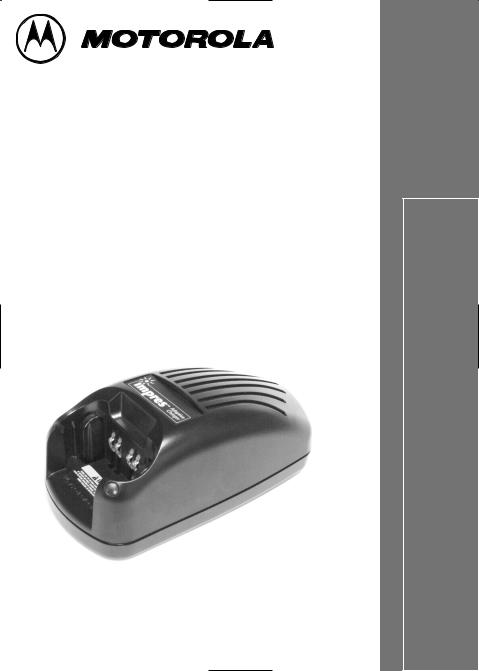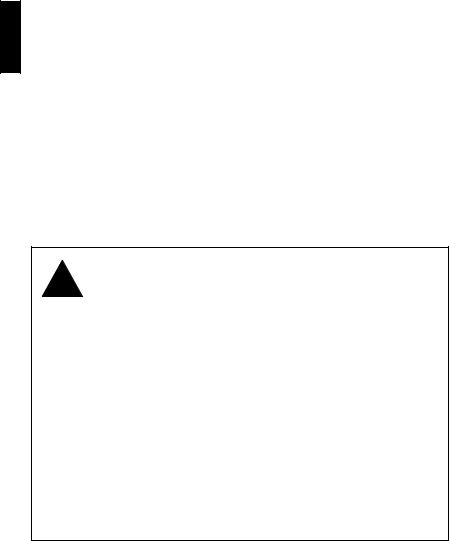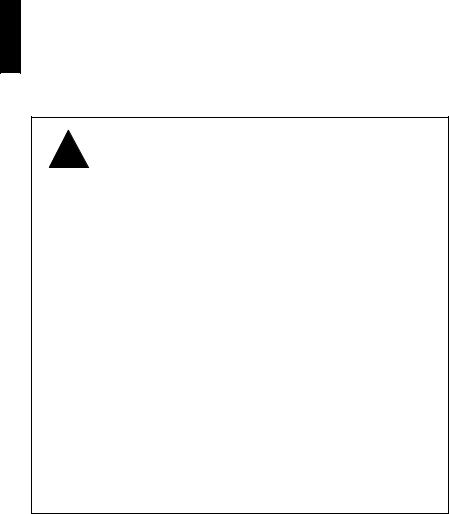Motorola WPLN4113, WPLN4112, WPLN4122, WPLN4115, WPLN4116 User Manual
...
IMPRES™
Adaptive Single Unit Charger
Chargeur autoadaptable individuel
Carregador auto adaptável individual
Cargador autoadaptable individual
WPLN4111, WPLN4112, WPLN4113, WPLN4114,
WPLN4115, WPLN4116, WPLN4117, WPLN4122
Accessories
6880309K98-A

and MOTOROLA are registered trademarks of Motorola, Inc. IMPRES is a trademark of Motorola, Inc.
et MOTOROLA sont des marques déposées de Motorola, Inc. IMPRES est une marque commerciale de Motorola, Inc.
e MOTOROLA são marcas registradas da Motorola, Inc. IMPRES é uma marca comercial da Motorola, Inc.
y MOTOROLA son marcas registradas de Motorola, Inc. IMPRES es una marca comercial de Motorola, Inc.

TABLE OF CONTENTS
Important Safety Instructions . . . . . . . . . . . . . . . . . . . . . . . . . . . . . . . . 2
Operational Safety Guidelines . . . . . . . . . . . . . . . . . . . . . . . . . . . . . . . 3
IMPRES Feature/Benefit Description. . . . . . . . . . . . . . . . . . . . . . . . . . 3
Operational Characteristics/Differences . . . . . . . . . . . . . . . . . . . . . . . 4
Power Sources and Motorola Authorized Power Adapters . . . . . . . . . 7
Operating Instructions . . . . . . . . . . . . . . . . . . . . . . . . . . . . . . . . . . . . . 8 Charging the Battery . . . . . . . . . . . . . . . . . . . . . . . . . . . . . . . . . . . 10 Manually Reconditioning the Battery . . . . . . . . . . . . . . . . . . . . . . . 11 Automatically Reconditioning the Battery . . . . . . . . . . . . . . . . . . . 11 Manually Terminating the Reconditioning Process . . . . . . . . . . . . 12 Removing a Radio or Battery from the Charger . . . . . . . . . . . . . . 12
Troubleshooting . . . . . . . . . . . . . . . . . . . . . . . . . . . . . . . . . . . . . . . . . 12
Service. . . . . . . . . . . . . . . . . . . . . . . . . . . . . . . . . . . . . . . . . . . . . . . . 14
English
1

English
THE IMPRES ADAPTIVE CHARGER IS UNLIKE ANY CHARGING DEVICE YOU HAVE EVER USED BEFORE.
IMPORTANT
SAFETY INSTRUCTIONS
SAVE THESE INSTRUCTIONS
This document contains important safety and operating instructions. Please read these instructions carefully and save them for future reference.
Before using the battery charger, read all the instructions and cautionary markings on (1) the charger and (2) the battery (3) and on the radio using the battery.
1.To reduce risk of injury, charge only the rechargeable
!Motorola authorized batteries listed in Tables 1 through 5. Other batteries may explode, causing personal injury
WARNING |
and damage. |
2.Use of accessories not recommended by Motorola may result in risk of fire, electric shock, or injury.
3.To reduce risk of damage to the electric plug and cord, pull by the plug rather than the cord when disconnecting the charger.
4.An extension cord should not be used unless absolutely necessary. Use of an improper extension cord could result in risk of fire and electric shock. If an extension cord must be used, make sure that the cord size is 18AWG for lengths of up to 100 feet (30.48m), and 16AWG for lengths up to 150 feet (45.72m).
5.To reduce risk of fire, electric shock, or injury, do not operate the charger if it has been broken or damaged in any way. Take it to a qualified Motorola service representative.
2

WARNINGS (continued) |
|
|
|
! |
6. Do not disassemble the charger – it is not repairable |
English |
|
of the charger may result in risk of electric shock or fire. |
|||
|
and replacement parts are not available. Disassembly |
|
|
WARNING |
7. To reduce risk of electric shock, unplug the charger from the |
|
|
|
|
||
|
ac outlet before attempting any maintenance or cleaning. |
|
|
8.For fuse replacement, use only fuses of the same type and rating listed on the charger label.
OPERATIONAL SAFETY GUIDELINES
•Turn the radio off when charging the battery.
•This equipment is not suitable for outdoor use. Use only in dry locations/conditions.
•Connect equipment only to an appropriately fused and wired supply of the correct voltage (as specified on the product).
•Disconnect from line voltage by removing the mains plug from the outlet.
•The socket outlet to which this equipment is connected should be close and easily accessible.
•For equipment using fuses, replacements must comply with the type and rating specified in the equipment instructions.
•Maximum ambient temperature around the charger must not exceed 40˚C (104˚F).
•Make sure the cord is located where it will not be stepped on, tripped over, or subjected to water, damage, or stress.
IMPRES FEATURE / BENEFIT DESCRIPTION
The IMPRES energy solution is an advanced TriChemistry energy system developed by Motorola which encompasses (a) IMPRES batteries,
(b) the IMPRES Adaptive Charger, and (c) radio hardware / software
3

English
which provides the capability for IMPRES compatible radios to communicate with IMPRES batteries.
The IMPRES Adaptive Charger, when used in conjunction with Motorola IMPRES batteries will:
1.Maximize operation time between charge cycles by automatically eliminating memory effect.
2.Maximize battery life by significantly reducing heat during the trickle and post charge cycles.
3.Eliminate the need to purchase reconditioning equipment and train personnel to “manage battery maintenance tasks.”
With this unique patented system approach, there is no need to track and record battery use, conduct manual reconditioning cycles or remove batteries from chargers following charging.
The IMPRES Adaptive Charger monitors the usage pattern of the IMPRES battery, stores that information in the IMPRES battery, and performs a recondition cycle only when needed.
The IMPRES Adaptive Charger will not overheat the battery regardless of how long it is left in the pocket. The charger monitors the battery and automatically “tops off” the battery, as required.
The IMPRES Adaptive Charger simplifies the charging and battery care process: All a user needs to do is follow these simple steps:
1.Place the radio / battery in the charger
2.Remove the radio / battery when it's fully charged!
Motorola is the only manufacturer that offers a conditioning or reconditioning charger that provides users with the choice of charging the radio with the battery attached or the battery separately.
OPERATIONAL CHARACTERISTICS / DIFFERENCES
1.IMPRES batteries may be charged in conventional chargers. However, in order for the Smart Energy features to be enabled, each IMPRES battery must be charged in an IMPRES Adaptive Charger. The first time an IMPRES battery is charged in an IMPRES Adap-
4

tive Charger, the charger initially indicates a STEADY YELLOW on the charger indicator. This first charge must be allowed to complete to a STEADY GREEN indication on the charger indicator. This properly calibrates the IMPRES battery and enables the Smart Energy features. If this process is interrupted, the charger will calibrate the battery upon the next insertion.
2.Since the IMPRES Adaptive Charger automatically determines the conditions necessary to recondition the IMPRES battery, the charger may go into recondition mode when a radio or battery is inserted. This is indicated by a STEADY YELLOW on the charger indicator. The recondition mode can be over ridden, if required, by removing and reinserting the radio or battery. (Please see instructions later in this guide.)
3.The IMPRES Adaptive Charger is designed to charge any battery listed in Tables 1 through 5. However, only genuine IMPRES batteries will provide Smart Energy features. (As new radio or battery models are introduced, this list will be amended and distributed to customers via the various Global OEM and Aftermarket organizations)
4.The IMPRES Adaptive Charger must be used to calibrate IMPRES Smart batteries to ensure they accurately record, store and display IMPRES battery usage data.
Table 1. XTS3000 / XTS3500 / Dimetra Series Radios
& XTS5000 Digital Radio
Kit (PN) |
Chemistry |
FM |
Smart |
Capacity |
New Model |
|
HNN9031 |
NiCD |
No |
Yes |
Ultra High |
No |
|
HNN9032 |
NiCD |
Yes |
Yes |
Ultra High |
No |
|
NTN8294 |
NiCD |
No |
No |
Ultra High |
No |
|
|
|
|
|
|
|
|
NTN8295 |
NiCD |
Yes |
No |
Ultra High |
No |
|
NTN8297 |
NiCD |
Yes |
No |
Ultra High |
No / Rugged |
|
NTN8299 |
NiCD |
Yes |
No |
Ultra High |
No |
|
|
|
|
|
|
|
|
NTN8610 |
LiIon |
No |
No |
High |
No |
|
|
|
|
|
|
|
|
NTN8293 |
NiMH |
No |
No |
Ultra High |
No |
|
NTN9533 |
Lilon |
No |
Yes |
Ultra High |
New |
|
|
|
|
|
|
|
|
HTN6846 |
Lilon |
No |
Yes |
Ultra High |
New Slim |
|
|
|
|
|
|
|
|
RNN4006 |
NiMH |
No |
No |
Very High |
New / 3000 Mh |
|
RNN4007 |
NIMH |
Yes |
No |
Very High |
New / 3000 Mh |
|
|
|
|
|
|
|
English
5

Table 2. XTS2500 Digital Radios
|
|
Kit (PN) |
Chemistry |
FM |
Smart |
Capacity |
New Model |
|
|
||||||
|
|||||||
English |
|
NTN9859 |
NiMH |
No |
No |
Ultra High |
New |
|
NTN9815 |
NiCD |
No |
No |
High |
New |
|
|
|
NTN9857 |
NiMH |
Yes |
No |
Ultra High |
New |
|
|
|
|
|
|
|
|
|
|
NTN9816 |
NiCD |
Yes |
No |
High |
New |
Table 3. MTP700 Digital Radios
Kit (PN) |
Chemistry |
FM |
Smart |
Capacity |
New Model |
|
PMNN4048* |
NiMH |
No |
Yes |
High |
New |
|
PMNN4049* |
NiMH |
Yes |
Yes |
High |
New |
|
PMNN4050* |
Lilon |
No |
Yes |
High |
New |
|
|
|
|
|
|
|
|
PMNN4047* |
LiIon |
No |
Yes |
High |
New |
* Charger requires battery adapter part number RLN5211A to charge MTP700 batteries.
Table 4. HT1000 / MT2000 / MTS2000 / MTX8000
& MTX9000 Series Radios
Kit (PN) |
Chemistry |
FM |
Smart |
Capacity |
New Model |
|
HNN9028 |
NiCD |
No |
Yes |
Ultra High |
No |
|
HNN9029 |
NiCD |
Yes |
Yes |
Ultra High |
No |
|
|
|
|
|
|
|
|
NTN7143 |
NiCD |
No |
No |
High |
No |
|
NTN7144 |
NiCD |
No |
No |
Ultra High |
No |
|
NTN7146 |
NiCD |
Yes |
No |
High |
No |
|
|
|
|
|
|
|
|
NTN7147 |
NiCD |
Yes |
No |
Ultra High |
No |
|
NTN7148 |
NiCD |
Cenelec |
No |
High |
No |
|
NTN7149 |
NiCD |
CSA |
No |
High |
No |
|
|
|
|
|
|
|
|
NTN7150 |
NiCD |
MSHA |
No |
High |
No |
|
NTN7341 |
NiCD |
Yes |
No |
Ultra High |
No |
|
NTN7372 |
NiCD |
Yes |
No |
High |
No |
|
|
|
|
|
|
|
|
WPPN4013 |
NiMH |
No |
No |
Ultra High |
No |
|
|
|
|
|
|
|
|
WPPN4037 |
NiMH |
Yes |
No |
Ultra high |
No |
6

Table 5. Saber / Astro Saber Radios
Kit (PN) |
Chemistry |
FM |
Smart |
Capacity |
New Model |
|
|
|
|
||||||
|
|||||||
HNN9033 |
NiCD |
No |
Yes |
Ultra High |
No |
|
English |
NTN4537** |
NiCD |
Yes |
No |
Low |
No |
|
|
HNN9031 |
NiCD |
Yes |
Yes |
Ultra High |
No |
|
|
|
|
|
|
|
|
|
|
NTN4538 |
NiCD |
Yes |
No |
High |
No |
|
|
NTN4592** |
NiCD |
No |
No |
Low |
No |
|
|
|
|
|
|
|
|
|
|
NTN4593 |
NiCD |
No |
No |
High |
No |
|
|
NTN4595 |
NiCD |
No |
No |
Ultra High |
No |
|
|
NTN4596 |
NiCD |
Yes |
No |
Ultra High |
No |
|
|
|
|
|
|
|
|
|
|
NTN4657 |
NiCD |
No |
No |
High |
No |
|
|
NTN4671 |
NiCD |
Cenelec |
No |
High |
No |
|
|
NTN4992 |
NiCD |
Yes |
No |
Ultra High |
No |
|
|
|
|
|
|
|
|
|
|
NTN7014** |
NiMH |
No |
No |
High |
No |
|
|
NTN7058 |
NiCD |
Yes |
No |
Ultra High |
No |
|
|
NTN7426 |
NiCD |
Yes |
No |
Low |
No |
|
|
|
|
|
|
|
|
|
|
NTN8251 |
NiMH |
Yes |
No |
Ultra High |
No |
|
|
NTN8818** |
LiIon |
No |
No |
High |
No |
|
|
**Charger requires battery adapter part number 5887135S01 to charge Astro Saber batteries.
POWER SOURCES AND MOTOROLA AUTHORIZED POWER ADAPTERS
This charger is designed for use in 100 V ac to 240 V ac, 50/60 Hz applications and uses the following Motorola power cords:
Table 6.
Plug Type |
Charger Kit |
Power Cord |
|
No Power cord / plug |
WPLN4114AR |
None |
|
U.S./NA |
WPLN4111AR |
3004209T03 |
|
Euro |
WPLN4112AR |
3004209T01 |
|
|
|
|
|
U.S/NA |
WPLN4117AR |
3004209T03 |
|
|
|
|
|
U.K. |
WPLN4113AR |
3004209T02 |
|
Australia/NZ |
WPLN4115AR |
3004209T07 |
|
|
|
|
|
Argentina |
WPLN4116AR |
3004209T08 |
|
|
|
|
|
Korea |
WPLN4122AR |
3004209T01 |
7

English
OPERATING INSTRUCTIONS
NOTES
The adaptive charger charges only the Motorola authorized batteries listed in Tables 1 through 5. Other batteries may not charge.
The adaptive charger has automatic features and capabilities that are different from other battery chargers. Pay close attention to the charge indicator to ensure that the charger is in the desired/expected mode of operation.
The charger’s pocket accommodates either a radio with a battery attached or a battery alone. Prior to charging a radio with a battery, turn the radio off. Batteries charge best if they are at room temperature when charged.
1.Plug the charger end of the power cord into the ac receptacle located at the back of the charger.
2.Plug the wall receptacle end of the power cord into the appropriate ac outlet. A successful power-up sequence is indicated by a SINGLE FLASH GREEN on the charger indicator.
NOTE
If a battery requires one of the battery adapters (see Tables 3 and 5), push back the battery guide (inside rear of the pocket) and slide the battery adapter in place. When applicable, reverse the procedure to remove the adapter.
3.Insert a battery, or a radio with a battery (radio turned off), into the charger’s pocket by:
a.Aligning the groove on each side of the battery with the corresponding raised rail on each side of the charger pocket.
b.Pressing the battery toward the rear of the pocket.
c.Sliding the battery into the charger pocket, ensuring complete contact between the charger and battery contacts.
Once the battery is properly seated into the pocket, the charger indicator illuminates, indicating the charger has recognized the presence of the battery. Refer to the charging indicators in Table 7 on page 9.
8

Table 7.
Charge Indicator |
Description |
|
|
|
|
||
|
|||
Single Flash Green |
Charger has successfully powered up. |
|
English |
Flashing Green |
Battery has completed rapid charge (>90% available |
|
|
Steady Red |
Battery is in rapid charge mode. |
|
|
|
capacity). Battery is in Top-Off charge (Trickle charge). |
|
|
Steady Green |
Battery has completed charging and is fully charged. |
|
|
Flashing Yellow |
Battery is recognized by charger but is waiting to charge. |
|
|
|
(Either the battery voltage is too low or the battery tem- |
|
|
|
perature is too low or to high to allow charging. When |
|
|
|
this condition is corrected, the battery will begin charg- |
|
|
|
ing.) |
|
|
Flashing Red |
Battery is unchargeable or not making proper contact. |
|
|
Steady Yellow |
(This feature is for Smart batteries only) |
|
|
|
Battery is in recondition mode. The length of time the |
|
|
|
charger remains in this mode is dependent upon the |
|
|
|
state of charge remaining in the battery when inserted. |
|
|
|
(Fully charged batteries require more time to recondition |
|
|
|
– 8 hours or more - than fully discharged batteries.) |
|
|
Flashing Red/Green |
(This feature is for Smart batteries only) |
|
|
|
Battery has completed charging and is fully charged. |
|
|
|
Battery continues to be usable, but may be nearing the |
|
|
|
end of its rated service life. |
|
|
NOTE
The IMPRES Adaptive Charger is unique in that it has the ability, when used with Motorola IMPRES batteries, to automatically determine the need of the battery to be reconditioned.
In order for the features of Motorola Smart batteries and the Adaptive Charging System to be fully available, the data contained in Motorola Smart batteries must be initialized by the charger the first time it is charged. This process is indicated by a STEADY YELLOW on the charger indicator (the same as though the battery were reconditioning). The process is automatic, includes an initial reconditioning of the battery, and begins charging upon completion of this process. This process requires time to initialize the battery, so the battery should be left in the charger overnight on the initial insertion.
The IMPRES Adaptive Charger operates both as:
•a Charger with all Motorola authorized batteries, and
•a Reconditioner with Motorola authorized IMPRES batteries.
9

English
Charging the Battery
IMPORTANT:
The charger pocket is designed to accept several different battery shapes and sizes, so it is important to make certain that a radio with a battery attached or battery alone is inserted correctly. If a radio with a battery attached or battery alone is inserted incorrectly, the indicator will not illuminate, indicating that the battery is not being charged.
NOTE:
New batteries (never used before) prematurely indicate a full charge in some cases (STEADY GREEN indication)
To ensure optimum performance, Motorola recommends all new batteries be left in the charger 14 to 16 hours prior to initial use.
1.Once a battery or a radio with a battery is properly inserted into the charger, the charger begins to rapid charge the battery and is indicated by a STEADY RED on the charger indicator. The length of time the charger indicates STEADY RED is dependent upon the charge remaining in the battery.
2.Completion of rapid charge (>90% available capacity) is indicated by a FLASHING GREEN on the charger indicator. This indicates the “top-off” charge (trickle charge) and requires approximately 1 hour.
3.Completion of “top-off” charge is indicated by a STEADY GREEN on the charger indicator. This indicates the battery is fully charged.
4.Other indications that may appear on the charger indicator while charging are:
•FLASHING YELLOW – indicates that either the battery temperature or battery voltage is out of range for charging. Charging resumes when theses conditions have been corrected.
•FLASHING RED AND GREEN – indicates that the battery may be approaching the end of its rated service life. While this battery is fully charged, its charging capacity has been reduced by usage and may not adequately support heavier applications. This feature is available only when used with Motorola IMPRES batteries. This is not a fault indication, merely a notification to the user that the battery may soon no longer be able to yield expected service and may need to be replaced. When this indication occurs, contact you Motorola Dealer for replacement batteries.
10

• FLASHING RED – indicates that the battery is unchargeable.
This could be the result of a loss of contact between the battery |
|
|
|
||
and the charger. Charging resumes when the condition causing |
English |
|
this indication is corrected. |
||
|
||
Motorola Smart batteries have an internal memory device that is read |
|
|
by the Motorola IMPRES Adaptive Charger. If an IMPRES battery is |
|
|
charged for more than 2-1/2 minutes, the IMPRES Adaptive Charger |
|
|
retains the serial number of the IMPRES battery. The IMPRES battery |
|
|
may be removed from the charger for up to 30 minutes. Once the bat- |
|
|
tery is reinserted back into the charger, it will resume the charging pro- |
|
|
cess from that point from when the battery was first removed. |
|
|
Manually Reconditioning the Battery |
|
|
Within 2-1/2 minutes of the initial insertion of an IMPRES battery |
|
|
(STEADY RED indication), remove and reinsert the battery within 5 |
|
|
seconds to manually force reconditioning to occur. The charger indica- |
|
|
tor changes from a STEADY RED to a STEADY YELLOW. This forces |
|
|
the charger to recondition and automatically recharge the battery. |
|
NOTE:
Excessive use of this feature reduces the cycle life of the battery.
Automatically Reconditioning the Battery
The Motorola IMPRES Adaptive Charger, when used in conjunction with a Motorola IMPRES battery, has the ability to determine when it is appropriate to recondition the battery.
When an IMPRES battery is properly inserted into the charger, the charger determines if it is appropriate to recondition the battery. If the battery needs reconditioning, the charger automatically indicates a STEADY YELLOW. This process may take up to 8 hours or more to complete, depending upon the state of charge and capacity rating of the battery when it is inserted.
It is important to note, for this process to be effective, the battery must be allowed to complete the recondition/recharge process. Leave the battery in the charger until the charger indicates a
STEADY GREEN.
11

English
At the completion of the recondition cycle, the charger automatically recharges the battery.
Manually Terminating the Reconditioning Process
At any time during the reconditioning process of a Motorola IMPRES battery (STEADY YELLOW indication), reconditioning may be terminated by removing and reinserting the battery within 5 seconds. This causes the charger to terminate the reconditioning process and begin the charging process. The charger indicator changes to a STEADY RED.
Removing a Radio or Battery from the Charger
Use two hands to remove a radio or battery from the charger pocket – one hand to hold and support the charger, and the other hand to remove the radio or battery.
TROUBLESHOOTING
The IMPRES Adaptive Charger incorporates the features of:
•a universal input (100 V ac-240 V ac, 50/60 Hz) power supply
•a constant current rapid charger,
•an interrupted current (negative pulse) conditioning charger
•a reconditioning unit.
The combination of the features listed above are unique in a desktop charger. Therefore, operation of the radio with a battery attached while in the charger is not recommended.
While in the charger, radio operation may result in minimally reduced radio performance and extended battery charge time.
Additionally, the conditioning charge feature of this system creates an audible “ticking” sound in the receiving radio during the rapid and trickle charge modes of operation. This sound is caused by periodic discharge pulses to the battery. Should this sound be objectionable to the user, changing the switch position located on the bottom of the
12

charger from position “A” to position “B” reduces the frequency of the discharge pulses. This has a minimal impact on the effectiveness of the charger.
Towards the end of the rapid charge cycle (STEADY RED indication), the battery voltage exceeds the normal operating voltage of the radio. The voltage returns to a normal level following the rapid charge mode or when the battery is removed from the charger.
If the radio is turned on while the charger is in rapid charge mode, the radio becomes temporarily inoperable. This condition can be cleared by removing the radio from the charger and turning the radio off and on again.
During the reconditioning process, the battery becomes fully discharged. As a result, the radio may not function during reconditioning mode.
In some cases, such as use near fluorescent lighting or electric motors, a slight hum may be noticed in the receiving radio. If this occurs, moving the charger or repositioning the power cord should eliminate the hum.
When troubleshooting, always observe the charge indicator – Refer to Table 7 on page 9.
English
13

Table 8. Troubleshooting
|
|
Problem |
What it means... |
What to do... |
|||
|
|
||||||
|
|||||||
English |
|
No charger |
1a. |
Charger contact is not |
1a. |
Check that the radio with battery, |
|
|
indication |
|
being made. |
|
or the battery alone, is inserted |
||
|
|
|
|
||||
|
|
|
|
|
|
correctly. |
|
|
|
|
1b. |
No power to the charger. |
1b. |
Make sure that the power cord is |
|
|
|
|
|
|
|
securely plugged into the charg- |
|
|
|
|
|
|
|
er and an appropriate ac outlet, |
|
|
|
|
|
|
|
and that there is power to the out- |
|
|
|
|
|
|
|
let. |
|
|
|
Flashing Red |
2a. |
Charger contact is not |
2a. |
• |
Remove the battery from the |
|
|
Indication |
|
being made. |
|
|
charger and replace it back |
|
|
|
|
|
|
|
into the charger. |
|
|
|
|
|
|
• |
Verify that the battery is a |
|
|
|
|
|
|
|
Motorola authorized battery |
|
|
|
|
|
|
|
listed in Tables 1 through 5. |
|
|
|
|
|
|
|
Other batteries may not |
|
|
|
|
|
|
|
charge. |
|
|
|
|
|
|
• |
Remove power from the bat- |
|
|
|
|
|
|
|
tery charger and, using a clean |
|
|
|
|
|
|
|
dry cloth, clean the gold metal |
|
|
|
|
|
|
|
charging contacts of both the |
|
|
|
|
|
|
|
battery and the charger. |
|
|
|
2b. |
Battery is unchargeable. |
2b. |
Replace battery. |
|
|
|
Flashing Yellow |
3. |
Battery it waiting to |
3. |
When this condition is corrected, |
|
|
|
Indication |
|
charge. The battery tem- |
|
the battery will begin charging. |
|
|
|
|
|
perature may be below |
|
|
|
|
|
|
|
5˚C (41˚F) or above 40˚C |
|
|
|
|
|
|
|
(104˚F) or the battery |
|
|
|
|
|
|
|
voltage may be lower |
|
|
|
|
|
|
|
than the predetermined |
|
|
|
|
|
|
|
threshold level for rapid |
|
|
|
|
|
|
|
charging. |
|
|
|
SERVICE
Adaptive Single-unit Chargers are not repairable. Order replacement chargers as necessary from your local Motorola Sale Representative.
14

TABLE DES MATIÈRES
Consignes de sécurité importantes. . . . . . . . . . . . . . . . . . . . . . . . . . . . . . 2 Normes de sécurité relatives au fonctionnement . . . . . . . . . . . . . . . . . . . 3 Description des fonctions et options offertes par le chargeur IMPRES. . . 3 Caractéristiques et différences de fonctionnement . . . . . . . . . . . . . . . . . . 4 Voltages d’entrée et adaptateurs d’alimentation agréés Motorola. . . . . . . 7
Mode d’emploi . . . . . . . . . . . . . . . . . . . . . . . . . . . . . . . . . . . . . . . . . . . . . . 8 Charge de la batterie . . . . . . . . . . . . . . . . . . . . . . . . . . . . . . . . . . . . . 10 Remise en état manuelle de la batterie . . . . . . . . . . . . . . . . . . . . . . . 11 Remise en état automatique de la batterie . . . . . . . . . . . . . . . . . . . . . 11 Suspension manuelle du processus de remise en état . . . . . . . . . . . 12 Comment retirer la radio ou la batterie du chargeur . . . . . . . . . . . . . . 12
Dépannage . . . . . . . . . . . . . . . . . . . . . . . . . . . . . . . . . . . . . . . . . . . . . . . 12 Entretien et réparation. . . . . . . . . . . . . . . . . . . . . . . . . . . . . . . . . . . . . . . 14
Français
1

Français
LE CHARGEUR AUTOADAPTABLE IMPRESS NE RESSEMBLE À AUCUN DES DISPOSITIF DE CHARGE QUE VOUS AVEZ PU UTIILISER JUSQU’À PRÉSENT.
IMPORTANTES CONSIGNES
DE SÉCURITÉ À CONSERVER
Ce document contient des consignes de sécurité et de fonctionnement importantes. Veuillez les lire attentivement et les conserver pour référence.
Avant d’utiliser le chargeur de batterie, lire toutes les consignes et les mises en garde concernant (1) le chargeur et (2) la batterie.
1.Pour réduire les risques de lésion, chargez uniquement les batteries agréées Motorola figurant dans le
!Tableaus 1-5. L’utilisation d’autres types de batteries risquerait de provoquer une explosion et d’entraîner des
AVERTISSEMENT lésions et dommages personnels.
2. L’utilisation d’accessoires non recommandés par Motorola peut générer un incendie, un choc électrique ou des lésions.
3.Pour réduire le risque d’endommagement du cordon et de la prise électriques, tirez sur la prise et non pas sur le cordon pour déconnecter le chargeur.
4.Évitez d’utiliser une rallonge, sauf en cas d’absolue nécessité. L’utilisation d’une rallonge inadéquate risque de provoquer un incendie ou un choc électrique. Si vous devez utiliser une rallonge, veillez à ce que le calibre du câble soit de 18AWG jusqu’à 30 mètres (100 pieds) de long et de 16AWG jusqu’à 45 mètres (150 pieds) de long.
5.Afin de réduire les risques d’incendie, de choc électrique ou de lésions, évitez d’utiliser l’adaptateur s’il est cassé ou qu’il a subi un dommage quelconque. Faites-le réparer dans un centre d’entretien et de réparation agréé Motorola.
6.Ne démontez pas le chargeur ; l’unité n’est pas réparable et vous ne trouverez pas de pièces de rechange. En démontant le chargeur vous risquez de provoquer un choc électrique ou un incendie.
7.Afin de réduire les risques de choc électrique, débranchez le chargeur de la prise de courant alternatif avant de le nettoyer ou de procéder à son entretien.
8.Au moment de changer le fusible, veillez à utiliser un fusible de même tension nominale et de même type que ceux indiqués sur l’étiquette du chargeur.
2
